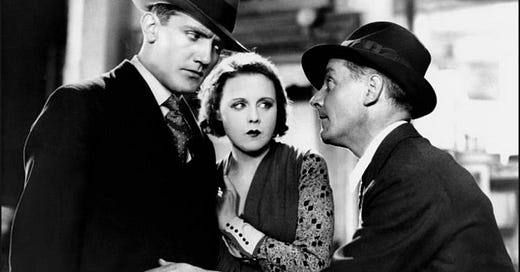Last week we looked at the history of the Talkies.
I have to admit it was a big subject to whittle down to a 1000 word newsletter. So I was pleased that I had this Further Viewing follow-up to add some extras!
There are plenty of bits and pieces to watch if this subject caught your eye. There are a selection of documentaries as well as film examples of early Talkies here for you to enjoy.
Thanks to everyone who subscribes to this newsletter. If you do enjoy my work, please consider a paid subscription to access this post and my other stuff! A subscription supports my research and is about the price of a cup of coffee.
All likes, reposts, shares and recommendations are all hugely appreciated too!
Let’s go!
Listen to This - 1978
The transition to the Talkies is a great example of what I like about movie history. It’s all there! It’s far back enough to be a window to another time, but close enough that everything is recorded, from the surface level news, right down to the cinema bills and old vinyl records. Though I explored different archives, nuggets like this were a joy to watch.
This 16 minute documentary ended up being a good lift off point for me. What I like about it is that it’s its own relic in a way, a voice from the past telling a story from even further back. I like how the archive footage is interspersed with the “modern” editors.
If you want an overview on the history of the time (beyond what I offered up!) then this is a good documentary to stick on. If you’re looking for something a little more in-depth…may I suggest…
A Deep Dive into the Transition to Sound
This is a fantastic video that gets into the weeds around the subject. What I love about this one are the quick examples of the early Talkie movies. Particularly their awkward nature, the long pauses and the actors having to stand still. We’ve seen a spoof of this kind of thing in other movies, but it’s fascinating to see them here.
To go even deeper, there is this 30 minuete documentary which takes you from the beginning to the modern day by FilmmakerIQ. Take your pic!
Blackmail & Other Early Talkies
“Sound did change everything, as the visual became the verbal and the allusional went literal. [T]he studios soon found ways to muffle motors, to liberate cameras from their ice-boxes and dub sound so that dialogue didn’t always have to be recorded live by performers huddled around a plant pot. Moreover, a number of filmmakers embraced the creative possibilities of sound, seeking ways to use it expressively and experimentally.” BFI
Along the way I found this useful list of films if you are interested in seeing some examples for yourself.
10 Great Early Sound Films - BFI
Each selection has an interesting commentary underneath which has made me want to watch every single one.
A good clean whack over the head with a brick is one thing…there’s something British about that. But a knife!? - Blackmail 1929
So far I’ve managed to watch one of Alfred Hitchcock’s earliest films, Blackmail from 1929. You can watch it on YouTube here.
What started filming as a silent was quickly adapted in to a Talkie as the new medium exploded. Both versions were released, with the silent version played to theatres not yet equipped to play sound. It was the first full length Talkie made in the U.K.
The use of sound is sparing at the beginning, but seems experimental and innovative as we move through the story. It’s a genuinely great film (it is a Hitchcock after all!) and for the most part you wouldn’t be able to tell they were experimenting with sound “on the hoof” as they were.
The film includes the first of his infamous cameos, and uses sound to represent the psychological state of the main character, something that we take for granted now but was new to cinema-goers then.
The Future of Sound
Surround sound at home was always the big talking point when I was growing up. Today, Dolby Atmos seems like the thing we’re seeing in everywhere. 3D sound where you can hear noise “in the space” is hugely effective. Though I’ve experienced it in my headphones, having this in the cinema is an even further leap forward than surround sound. Those Dolby clips at the beginning of the movie are getting seriously out of hand!
Beyond that, innovations in AI will change the movie making space in one way or another. Whether that’s creating sound effects, sound tracks or even voice generation, there will be studios trying these technologies out.
One interesting use of AI could be cleaning up the sound of older film, much like the use of technology to make The Beatles Now & Then and previous to that They Shall Not Grow Old, the World War One documentary by Peter Jackson that pioneered the technology.
Anything technology can do to enhance the work that artists already do to preserve movie heritage is welcome. So long as the artist remains.
There was a quote from one of the books I used in the first newsletter by Mr. J. W. Coffman,
“Science and Art are not natural enemies, rather, they are natural complements. Science reveals nature, art makes life liveable in spite of those revelations.
Science represents the accomplishments of man, art, his aspirations.”
Thanks for reading,
Gareth





